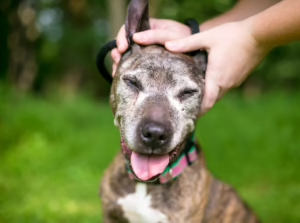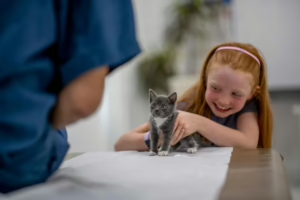Summer is a favorite time of year for so many, including our pets! Their kid-playmates are home, the days are longer, sunnier, and include sideline sports-watching, patio happy hours, backyard sprinklers, and road trips to the lake or beach. And while we all love summer for its many outdoor and social activities, hot weather comes with its own risks to pet safety. Some of these hazards can even prove to be fatal, such as heatstroke, drowning or hot cars.
Here are some summer tips for pets to help everyone enjoy the season safely!
1. Hydration is Key
Warm weather increases the risk of overheating because dogs and cats don’t release heat as efficiently as people. They rely on panting and limited sweating through their paws. Which is why pets need to stay hydrated, especially during the warmer months.
Make sure fresh, clean water is always available, whether at home or during outings. Avoid water bowls left in the sun or filled with old water. For a fun and refreshing treat, try adding ice cubes to their water bowls.
2. Beware of Heatstroke
Heatstroke is a serious risk during summer. It can happen quickly when pets are left outside without shade, exercised in high heat (or even moderate heat with high humidity), or confined in spaces without airflow.
Signs of heatstroke include heavy panting, drooling, weakness, vomiting, and collapse. If you suspect your pet has heatstroke, immediately move them to a cool area, provide cool (not cold) water, and consult a veterinarian right away. Read our heat stroke blog to learn more about the signs of heat stroke and how to respond.
3. Preventative Health and Parasite Prevention
Don’t let pests and parasites spoil the summer! If your pet is overdue for a wellness exam, early summer is a good time to check in with your veterinarian. Annual wellness exams help catch early signs of illness and make sure your pet’s care is up to date before the season peaks.
Warm weather also brings a spike in parasites like fleas, ticks, and mosquitoes. These pests are more than a nuisance— they can cause nonstop scratching, allergic reactions or harmful diseases like Lyme disease or heartworms. Preventive medications protect your pet throughout the season and should be given consistently. To be cautious, make sure your pet is up to date on all their flea, tick and heartworm prevention medications.
4. Sun Protection is Not Just for Humans
While it might sound surprising, pets can get sunburned too! Dogs with short hair, light-colored coats, or pale skin are particularly at risk. Consider applying pet-safe sunscreen on exposed areas such as noses and ears, and try to limit their sun exposure during peak hours. Providing shaded areas in your yard or carrying a portable pet tent can also be beneficial.
5. Watch Those Paws
Be aware of hot pavement! Streets, sidewalks and especially asphalt can reach over 130°F on sunny days. Don’t risk painful burns on your dog’s paw pads and be mindful of the 7-Second Rule.
Place the back of your hand on the ground surface for seven seconds. If the ground feels too hot for your hand, it’s too hot for paws. To avoid burns, walk during early morning or evening hours when it’s cooler, or hike with your dog down grassy paths or covered trails. Dog booties can also help protect paw pads during midday outings.
6. Say “No” to Hot, Parked Cars
Never ever leave your pet in a hot car — even parking in a shaded area with the windows cracked open isn’t safe. The temperature can rise 20 degrees within only 10 minutes and continues to climb as time goes on. This means a car can get dangerously hot in a very short time and can trigger a fatal heat stroke – so it’s never worth the risk!
7. Lifeguarding For Your Pet
Just like with kids – it’s important to take precautions for dogs around open bodies of water. Here’s some swimming safety tips for dogs:
- Never leave a dog unattended in or near open water. Even the best doggy paddlers can suddenly get tired, caught in a current, or need help getting out of a pool — any of which can put them at risk of drowning.
- Be honest about assessing your dog’s ability to swim and affinity for water – not all dogs are natural swimmers, and you should never force them to be.
- Consider a canine life vest when boating or for when you’re unable to keep a close eye on your dog around water.
- Avoid letting your dog drink too much salt water or chlorinated water, both of which can make them sick. Ensure there is always fresh water available for them to drink and remember to rinse off their fur after swimming.
- Always check standing water for abnormal colors or a scum that resembles spilled paint or pea soup. This blue-green algae could really be Cyanobacteria, which is toxic and can potentially poison your pet.
8. Not All Greens Are Good
For pet parents with a green thumb, being aware of potential risks in your backyard or garden is the best way to enjoy the outdoors with your pet’s safety in mind.
- Use caution when using herbicides or insecticides, as fertilizer exposures are more common in the summer and can become more serious than just an upset stomach.
- Be mindful of what plants are toxic and which ones are safe for your pets. As a resource, read our past blogs to familiarize yourself with toxic plants and avoid unwanted exposures.
- Additionally, keep citronella candles, tiki torch products, firewood, and pool chemicals out of reach from pets.
Special note: Breed Vulnerabilities and Special Cases
Some pets are more sensitive to heat than others. Brachycephalic breeds like Bulldogs and Pugs have short snouts and narrowed airways, making it harder for them to breathe and cool themselves. They overheat faster than other dogs.
Obese pets and seniors also have lower heat tolerance. They may tire easily or struggle to regulate body temperature. Before summer peaks, ask your veterinarian if any medication changes are needed. Some prescriptions affect hydration or increase sensitivity to sunlight.
While summer does carry some risks, there’s no need to be timid. With attention to hydration, heat safety, and preventive care, you and your pet can enjoy the season safely!




